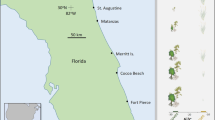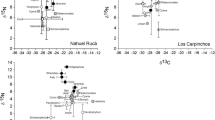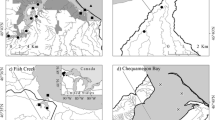Abstract
We examined the effects of hydrology and nutrients on the food webs of ten coastal wetlands on Lake Superior, using published stable isotope food web data for three wetlands and original data from seven additional systems in order to span regional hydrologic and nutrient enrichment gradients. We used a dual-source isotope mixing model to estimate the proportion of carbon in fish that originated from planktonic versus periphytic invertebrates, and we related carbon source to 1) nutrient enrichment, 2) hydraulic residence time, and 3) an index of nutrient loading that incorporates residence time and nutrient concentrations. There was no relationship between nutrient enrichment and the proportion of planktonic versus periphytic C in fish. Proportion of planktonic C in fish increased significantly with hydraulic residence time (F = 5.68, R2 = 0.42, p = 0.044). Riverine wetlands generally had lowest proportions of planktonic C in fish, dendritic wetlands were intermediate, and lagoon wetlands had highest proportions. A regression between the loading index and planktonic C in fish was an improvement over the residence time regression (F = 11.7, R2 = 0.59, p = 0.009). We conclude that coastal wetland food webs are strongly affected by hydrology and further by nutrient enrichment. This work has implications for the development of food web-based ecological indicators of nutrient enrichment and the use of hydrology as a classification factor in the prediction of nutrient effects on food webs.
Similar content being viewed by others
Literature Cited
Aday, D. D., D. E. Shoup, J. A. Neviackas, J. L. Kline, and D. H. Wahl. 2005. Prey community responses to bluegill and gizzard shad foraging: implications of growth of juvenile largemouth bass. Transactions of the American Fisheries Society 134: 1091–1102.
Albert, D. A., D. A. Wilcox, J. W. Ingram, and T. A. Thompson. 2005. Hydrogeomorphic classification for Great Lakes coastal wetlands. Journal of Great Lakes Research 31(Supplement 1): 129–146.
Ameel, J. J., R. P. Axler, and C. J. Owen. 1993. Persulfate digestion for determination of total nitrogen and phosphorous in lownutrient waters. American Environmental Laboratory 5: 1, 8–11.
Becker, G. C. 1983. Fishes of Wisconsin. University of Wisconsin Press, Madison, WI, USA.
Brazner, J. C. 1997. Regional, habitat, and human development influences on coastal wetland and beach fish assemblages in Green Bay, Lake Michigan. Journal of Great Lakes Research 23: 36–51.
Brazner, J. C., M. E. Sierszen, J. R. Keough, and D. K. Tanner. 2000. Assessing the ecological importance of coastal wetlands in a large lake context. Verhandlungen Internationale Vereinigung für theoretische und angewandte Limnologie 27: 1950–1961.
Cabana, G. and J. B. Rasmussen. 1994. Modelling food chain structure and contaminant bioaccumulation using stable nitrogen isotopes. Nature 372: 255–257.
Chow-Fraser, P. 1998. A conceptual ecological model to aid restoration of Cootes Paradise Marsh, a degraded coastal wetland of Lake Ontario, Canada. Wetlands Ecology and Management 6: 43–57.
Danz, N. P., R. R. Regal, G. J. Niemi, V. J. Brady, T. Hollenhorst, L. B. Johnson, G. E. Host, J. A. Hanowski, C. A. Johnston, T. Brown, J. Kingston, and J. R. Kelly. 2005. Environmentally stratified sampling design for the development of Great Lakes environmental indicators. Environmental Monitoring and Assessment 102: 41–65.
DeNiro, M. J. and S. Epstein. 1978. Influence of diet on the distribution of carbon isotopes in animals. Geochimica Cosmochimica Acta 42: 495–506.
DeNiro, M. J. and S. Epstein. 1981. Influence of diet on the distribution of nitrogen isotopes in animals. Geochimica Cosmochimica Acta 45: 341–351.
Doucett, R. R., W. Hooper, and G. Power. 1999. Identification of anadromous and nonanadromous adult brook trout and their progeny in the Tabusintac River, New Brunswick, by means of multiple-stable-isotope analysis. Transactions of the American Fisheries Society 128: 278–288.
Doucett, R. R., G. Power, D. R. Barton, R. J. Drimmie, and R. A. Cunjak. 1996. Stable isotope analysis of nutrient pathways leading to Atlantic salmon. Canadian Journal of Fisheries and Aquatic Sciences 53: 2058–2066.
Dyer, K. R. and P. A. Taylor. 1973. A simple, segmented prism model of tidal mixing in well-mixed estuaries. Estuarine and Coastal Marine Science 1: 411–418.
Fitzpatrick, F. A., J. C. Knox, and H. E. Whitman. 1999. Effects of historical land-cover changes on flooding and sedimentation, North Fish Creek, Wisconsin. United States Geological Survey Water-Resources Investigations Report 99-4083.
France, R. 1995. Differentiation between littoral and pelagic food webs in lakes using stable carbon isotopes. Limnology and Oceanography 40: 1310–1313.
Fry, B. and E. B. Sherr. 1984. δ13C measurements as indicators of carbon flow in marine and freshwater ecosystems. Contributions to Marine Science 27: 13–47.
Hansson, L.-A. 1988. Effects of competitive interactions on the biomass development of planktonic and periphytic algae in lakes. Limnology and Oceanography 33: 121–128.
Hansson, L.-A. 1992. Factors regulating periphytic algal biomass. Limnology and Oceanography 37: 322–328.
Hobson, K. A. and H. E. Welch. 1995. Cannibalism and trophic structure in a high Arctic lake: insights from stable-isotope analysis. Canadian Journal of Fisheries and Aquatic Sciences 52: 1195–1201.
Howarth, R. W., G. Billen, D. Swaney, A. Townsend, N. Jaworski, K. Lajtha, J. A. Downing, R. Elmgren, N. Caraco, T. Jordan, F. Berendse, J. Freney, V. Kudeyarov, P. Murdoch, and Z.-L. Zhu. 1996. Regional nitrogen budgets and riverine N and P fluxes for the drainages to the North Atlantic Ocean: natural and human influences. Biogeochemistry 36: 75–139.
Hynes, H. B. N. 1970. The Ecology of Running Waters. University of Toronto Press, Toronto, ON, Canada.
Jones, J. I. and S. Waldron. 2003. Combined stable isotope and gut contents analysis of food webs in plant-dominated, shallow lakes. Freshwater Biology 48: 1396–1407.
Jones, R. A. and G. F. Lee. 1986. Eutrophication modeling for water quality management: an update of the Vollenweider —OECD model. World Health Organization Water Quality Bulletin 11: 67–74.
Jude, D. J. and J. Pappas. 1992. Fish utilization of Great Lakes coastal wetlands. Journal of Great Lakes Research 18: 651–672.
Junger, M. and D. Planas. 1994. Quantitative use of stable carbon isotope analysis to determine the trophic base of invertebrate communities in a boreal forest lotic system. Canadian Journal Fisheries and Aquatic Sciences 51: 52–61.
Kelly, J. R. 2001. Nitrogen effects on coastal marine ecosystems. p. 207–252. In R. F. Follett and J. L. Hatfield (eds.) Nitrogen in the Environment: Sources, Problems, and Management. Elsevier Science, New York, NY, USA.
Keough, J. R., M. E. Sierszen, and C. A. Hagley. 1996. Analysis of a Lake Superior coastal food web with stable isotope techniques. Limnology and Oceanography 41: 136–143.
Keough, J. R., T. A. Thompson, G. R. Guntenspergen, and D. A. Wilcox. 1999. Hydrogeomorphic factors and ecosystem responses in coastal wetlands of the Great Lakes. Wetlands 19: 821–834.
Kidd, K. A., M. J. Paterson, R. H. Hesslein, D. C. G. Muir, and R. E. Hecky. 1999. Effects of northern pike (Esox lucius) additions on pollutant accumulation and food web structure, as determined by δ13C and δ15N, in a eutrophic and an oligotrophic lake. Canadian Journal of Fisheries and Aquatic Sciences 56: 2193–2202.
Krieger, K. A. and D. M. Klarer. 1991. Zooplankton dynamics in a Great Lakes coastal marsh. Journal of Great Lakes Research 17: 255–269.
Krieger, K. S., D. M. Klarer, R. T. Heath, and C. E. Herdendorf. 1992. A call for research on Great Lakes coastal wetlands. Journal of Great Lakes Research 18: 525–528.
Lamberti, G. A. 1996. The role of periphyton in benthic food webs. p. 533–571. In R. J. Stevenson, J. L. Bothwell, and R. L. Lowe (eds.) Algal Ecology: Freshwater Benthic Ecosystems. Academic Press, New York, NY, USA.
Lougheed, V. L. and P. Chow-Fraser. 1996. Factors that regulate the Zooplankton community structure of a turbid, hypereutrophic Great Lakes wetland. Canadian Journal of Fisheries and Aquatic Sciences 55: 150–161.
Lougheed, V. L. and P. Chow-Fraser. 2002. Development and use of a Zooplankton index of wetland quality in the Laurentian Great Lakes basin. Ecological Applications 12: 474–486.
Lougheed, V. L., B. Crosby, and P. Chow-Fraser. 1998. Predictions on the effect of carp exclusion on water turbidity, Zooplankton, and submergent macrophytes in a Great Lakes wetland. Canadian Journal of Fisheries and Aquatic Sciences 55: 1189–1197.
McNair, S. A. and P. Chow-Fraser. 2003. Change in biomass of benthic and planktonic algae along a disturbance gradient for 24 Great Lakes coastal wetlands. Canadian Journal of Fisheries and Aquatic Sciences 60: 676–689.
Minc, L. D. and D. A. Albert. 1998. Great Lakes coastal wetlands: abiotic and floristic characterization. Michigan Natural Features Inventory, Lansing, MI, USA.
Mortimer, C. H. 1974. Lake hydrodynamics. Mitteilungen Internationale Vereinigung für theoretische und angewandte Limnologie 20: 124–197.
Nixon, S. W., J. W. Ammerman, L. P. Atkinson, V. M. Berounsky, G. Billen, W. C. Boicourt, W. R. Boynton, T. M. Church, D. M. Ditoro, R. Elmgren, J. H. Garber, A. E. Giblin, R. A. Jahnke, H. J. P. Owens, M. E. Q. Pilson, and S. P. Seitzinger. 1996. The fate of nitrogen and phosphorus at the land-sea margin of the North Atlantic Ocean. Biogeochemistry 35: 141–180.
Post, D. M. 2002. Using stable isotopes to estimate trophic position: models, methods, and assumptions. Ecology 83: 703–718.
Sand-Jensen, K. and J. Borum. 1991. Interactions among phytoplankton, periphyton, and macrophytes in temperate freshwaters and estuaries. Aquatic Botany 41: 137–175.
Sather, L. M. and S. I. Johannes. 1972. Surface water resources of Douglas County. Wisconsin Department of Natural Resources, Madison, WI, USA.
Sierszen, M. E., J. A. Morrice, M. F. Moffett, and C. W. West. 2004. Benthic versus planktonic foundations of three Lake Superior coastal wetland food webs. Journal of Great Lakes Research 30: 31–43.
Sorensen, J., M. Sydor, M. Huls, and M. Costello. 2004. Analyses of Lake Superior seiche activity for estimating effects on pollution transport in the St. Louis River estuary under extreme conditions. Journal of Great Lakes Research 30: 293–300.
Stephenson, T. D. 1988. Fish utilization of Toronto area coastal marshes. M.S. Thesis. University of Toronto, Toronto, ON, Canada.
Stephenson, T. D. 1990. Fish reproductive utilization of coastal marshes of Lake Ontario near Toronto. Journal of Great Lakes Research 16: 71–81.
Tobias, C. R., M. Cieri, B. J. Peterson, L. A. Deegan, J. Vallino, and J. Hughes. 2003. Processing watershed-derived nitrogen in a well-flushed New England estuary. Limnology and Oceanography 48: 1766–1778.
Trebitz, A. S. 2006. Characterizing seiche and tide-driven daily water level fluctuations affecting coastal ecosystems of the astal marsh. Journal of Great Lakes Research 32: 102–116.
Trebitz, A. S., J. A. Morrice, and A. M. Cotter. 2002. Relative role of lake and tributary in hydrology of Lake Superior coastal wetlands. Journal of Great Lakes Research 28: 212–227.
U.S. EPA. 1983. Methods for Chemical Analysis of Water and Wastes. U.S. Environmental Protection Agency, Cincinnati, OH, USA.EPA/600/4-79/020.
U.S. EPA. 1993. Methods for the Determination of Inorganic Substances in Environmental Samples. U.S. Environmental Protection Agency, Cincinnati, OH, USA.EPA-6 00/R-93/100.
U.S. EPA. 2002. Aquatic Stressors: Framework and Implementation Plan for Effects Research. U.S. Environmental Protection Agency, Office of Research and Development, National Health and Environmental Effects Laboratory, Research Triangle Park, NC, USA.
Vadeboncoeur, Y., D. L. Lodge, and S. R. Carpenter. 2001. Whole-lake fertilization effects on distribution of primary production between benthic and pelagic habitats. Ecology 82: 1065–1077.
VanderKooy, K. E., C. F. Rakocinski, and R. W. Heard. 2000. Trophic relationships of three sunfishes (Lepomis spp.) in an estuarine bayou. Estuaries 23: 621–632.
Vander Zanden, M. J. and J. B. Rasmussen. 2001. Variation in δ15N and δ13C trophic fractionation: Implications for aquatic food web studies. Limnology and Oceanography 46: 2061–2066.
Wetzel, R. G. 1992. Wetlands as metabolic gates. Journal of Great Lakes Research 18: 529–532.
Whillans, T. H. 1982. Changes in marsh areas along the Canadian shoreline of Lake Ontario. Journal of Great Lakes Research 8: 570–577.
Whiteside, M. C. 1974. Chydorid (Cladoceran) ecology: Seasonal patterns and abundance of populations in Elk Lake, Minnesota. Ecology 55: 538–550.
Yoshioka, T., E. Wada, and H. Hayashi, H. 1994. A stable isotope study on seasonal food web dynamics in a eutrophic lake. Ecology 75: 835–846.
Zohary, T., J. Erez, M. Gophen, I. Berman-Frank, and M. Stiller. 1994. Seasonality of stable carbon isotopes within the pelagic food web of Lake Kinneret. Limnology and Oceanography 39: 1030–1043.
Author information
Authors and Affiliations
Corresponding author
Rights and permissions
About this article
Cite this article
Sierszen, M.E., Peterson, G.S., Trebitz, A.S. et al. Hydrology and nutrient effects on food-web structure in ten lake superior coastal wetlands. Wetlands 26, 951–964 (2006). https://doi.org/10.1672/0277-5212(2006)26[951:HANEOF]2.0.CO;2
Received:
Revised:
Accepted:
Issue Date:
DOI: https://doi.org/10.1672/0277-5212(2006)26[951:HANEOF]2.0.CO;2




